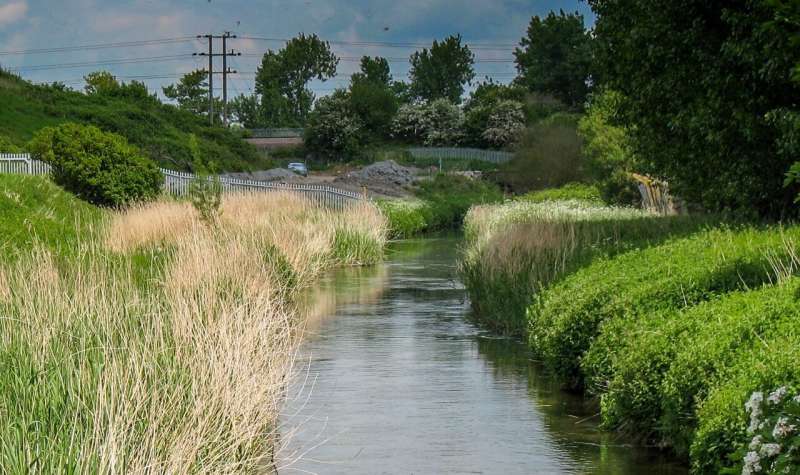Improved sewage treatment has increased biodiversity over past 30 years

A higher standard of wastewater treatment in the UK has been linked to substantial improvements in a river's biodiversity over the past 30 years, ensuring a welcome success story for wildlife, say scientists.
The Centre for Ecology & Hydrology analysed data from the regular monitoring of both chemicals and invertebrates in the River Ray in Wiltshire by the Environment Agency and its predecessors between 1977 and 2016. This Thames tributary is downstream from Swindon's large wastewater treatment plant.
The Defra-funded study found that, since 1991, there has been a steady increase in both the diversity and abundance of freshwater invertebrates, which play a vital and varied role in an ecosystem's food chain.
The water is cleaner due to a reduction in ammonia (a chemical present in human sewage that is potentially toxic to animals) plus an increase in oxygen levels (as a result of less organic matter being discharged into the river).
The findings, published in the journal Environmental Toxicology & Chemistry, echo other research which indicates there has been an increase in the biodiversity of many rivers across the UK. This latest analysis, which carefully examines four decades of chemistry and invertebrates data, offers an explanation why this has happened.
Professor Andrew Johnson of the Centre for Ecology & Hydrology, who led the study, explains: "There was a marked increase in the diversity and abundance of freshwater invertebrates on the River Ray immediately after 1991 and there has been a steady improvement since then. Therefore, we have identified Thames Water's investment in improved treatment to comply with the EU Urban Wastewater Directive, which was adopted that year, as the crucial turning point."
![Calopteryx splendens (banded demoiselle), a species of damselfly that was recorded in official sampling in the River Ray after 1991, following an absence of several years. Credit: Charles J Sharp [CC BY-SA 3.0] commons.wikimedia.org/wiki/File:Banded_Demoiselle_(Calopteryx_splendens)_male_adult.jpg Improved sewage treatment has increased biodiversity over past 30 years](https://scx1.b-cdn.net/csz/news/800a/2019/1-improvedsewa.jpg)
In practice, the implementation of the directive in the UK meant many large wastewater treatment plants including that at Swindon had to switch to the 'activated sludge' process, which is a more efficient way of dealing with large amounts of sewage water than the older 'trickling filter' system.
Professor Johnson says the previously lower standard of wastewater treatment, exacerbated by the increase in sewage produced by rapidly growing populations of towns like Swindon, had a negative impact on biodiversity. Many UK rivers had a low abundance of invertebrates and fish back in the 1960s, 70s and 80s.
Professor Johnson adds: "The fact there has been a continual increase in biodiversity in the Ray despite it being a small river taking the entire treated wastewater of a large town of 200,000 residents is extremely encouraging. It indicates that even for rivers with a very high wastewater content their fortunes can be turned around.
"It is wonderful to think that people walking by the Ray are seeing returning species of damselflies and caddisflies that they weren't seeing 30 years ago."
The privatisation of the UK water industry in 1989 meant the new water companies could borrow money to invest in their treatment plants to comply with higher standards, overseen by independent regulators. The industry spent £26 billion on various wastewater improvements between 1990 and 2015, according to Defra figures.
The European Union had been considering the merits of charcoal filtering as an additional, final stage of the wastewater treatment process to remove pharmaceuticals—a measure that could cost a total of £30 billion to introduce at treatment plants in England and Wales.
However, the analysis by CEH found the trial introduction of charcoal filtering at Swindon between 2008 and 2014 resulted in no significant increase in the diversity and abundance of freshwater invertebrates, over and above the existing improving trend.
More information: Andrew C. Johnson et al, What Works? The Influence Of Changing Wastewater Treatment Type, Including Tertiary Granular Activated Charcoal On Downstream Macroinvertebrate Biodiversity Over Time, Environmental Toxicology and Chemistry (2019). DOI: 10.1002/etc.4460
Ian P. Vaughan et al. Large-scale, long-term trends in British river macroinvertebrates, Global Change Biology (2012). DOI: 10.1111/j.1365-2486.2012.02662.x
Richard Owen et al. The hidden costs of flexible fertility, Nature (2012). DOI: 10.1038/485441a
Journal information: Environmental Toxicology and Chemistry , Global Change Biology , Nature
Provided by Centre for Ecology & Hydrology

















